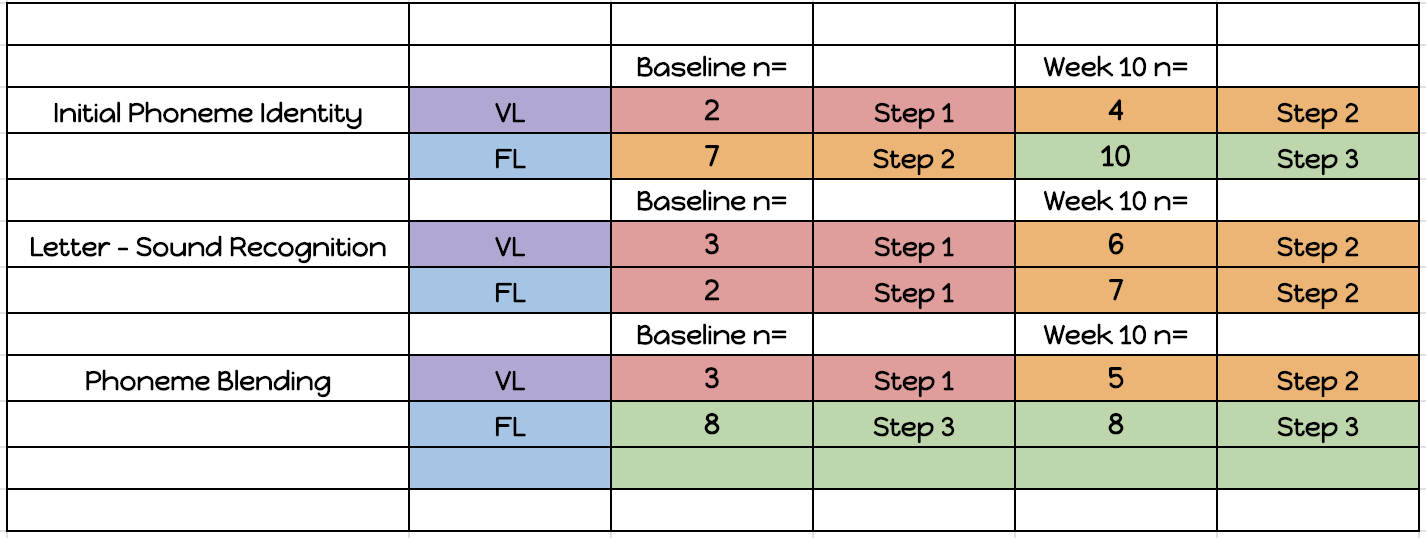As part of the Better Start Literacy Approach, I was required to conduct a case study on two students at the end of my ten-week teaching programme. One of my focusstudents had to demonstrate lower-level skills at baseline assessment.
What did the data say at the start of my teaching period?
My target students started BSLA in Term 4, 2022.
-FL started in Week 2.
-VL started in Week 3.
The baseline data showed that students:
-VL struggled to blend the sounds and had just a basic understanding of letters and sounds when she started school.
-FL had a greater understanding of letters and sounds at school entry and was able to confidently blend sounds.
What the data said 10 weeks later?
-VL moved from Step 1 to Step 2 in all 3 measures.
-FL moved from Step 1 to Step 2 across 2 measures ( phoneme identity and letter-sound recognition) and maintained his proficiency in phoneme blending and remained at Step 3.
-VL showed growth, particularly in letter sound recognition. She was quick and confident in her response to all the questions.
-FL maintained his understanding of phoneme blending and made expected progress in letter-sound recognition and initial phoneme identity.
Where has growth occurred?
-VL showed growth, particularly in letter sound recognition. She was quick and confident in her response to all the questions.
-FL maintained his understanding of phoneme blending and made expected progress in letter-sound recognition and initial phoneme identity.


My next steps for my focus students:
-Although VL showed that she made progress, her non-word reading and non-word spelling scores shows that she needs support to continue expanding her knowledge of letter sounds and practise combining sounds to decode words. Therefore I would consider her for Tier 2 support.
-At Kakano level, FL reached proficiency in non word reading and scored 80% showing that he is able to decode words.
His next steps will be to:
- expand his knowledge of complex vowel blends and digraphs which will be introduced in Taumata 2.
- apply this knowledge and skills to improve his reading and develop his writing independence.
How my focus children responded to the teaching and their engagement with small group reading.
Over the first two weeks, we read one book, concentrating on one page each day. Some students initially found it difficult to read in this manner, but with time and practice, they gained confidence and began to feel successful since they could apply the instruction from the warm-up to their reading. I started by only introducing one sound at a time to student VL, giving her all the words on the page until she felt confident enough to try more.
Facilitators of success for my focus children.
In week 10, students VL and FL made gains in all three measures. Student FL continued to do well in phoneme blending and remained on Step 3.
Describe challenges and facilitators of success when implementing the BSLA with your focus children.
The whole-class games and activities were enjoyable and engaging for the students, and they eagerly anticipated playing new games every day. One of the important factors in the success of my target students was their ability to apply this knowledge and skills to their reading and writing.
Challenges experienced by my focus children and how I enhanced my teaching practice to help overcome these challenges.If I compare this form of instruction to the years I spent teaching literacy, I realised that I have been "cognitively overloading students" by doing 3 readers each week, using alphabet cards that were visually distracting, using colourful magnetic letters for word manipulation and using resources that were over stimulating. Having more boys in my class was challenging. Students found it difficult to focus for 30 minutes during whole class games. I had to:
adapt the games, keeping them simple and short.
establish the classroom culture and norms for example, turn-taking and sharing.
have fluid groups which catered for individual student’s learning needs.
Reflection of my own learning:
Previously I followed Dr. Gwenneth Phillips Literacy Programme,and, being a qualified Reading Recovery teacher, I believed I was delivering an effective literacy program. However, since implementing the BSLA and monitoring student’s progress,I now recognize the advantages of phonological awareness instruction and interactive games to reinforce letter sounds, which encourage links between reading and writing. Additionally, in order for students to develop those connections between their reading and writing, it is crucial to teach every BLSA component. I've come to recognise how important it is to refrain from giving students too much information.
I was able to determine my strengths and weaknesses from my facilitator’s feedback, which led me to make adjustments to my teaching approach. For instance, I limited whole class games to just 30 minutes and chose activities with less preparation time, maintaining student engagement. Next term, I’m keen to implement the suggestion of using whiteboards and markers for word manipulation tasks in small group reading.
I am keen to continue teaching BSLA, actively address my weaknesses, and further broaden my current knowledge.
As I continue to learn to enhance my skills and develop my abilities, I feel more confident about teaching BSLA and fostering personal growth.

















